2010 CHEVROLET IMPALA ECU
[x] Cancel search: ECUPage 28 of 432
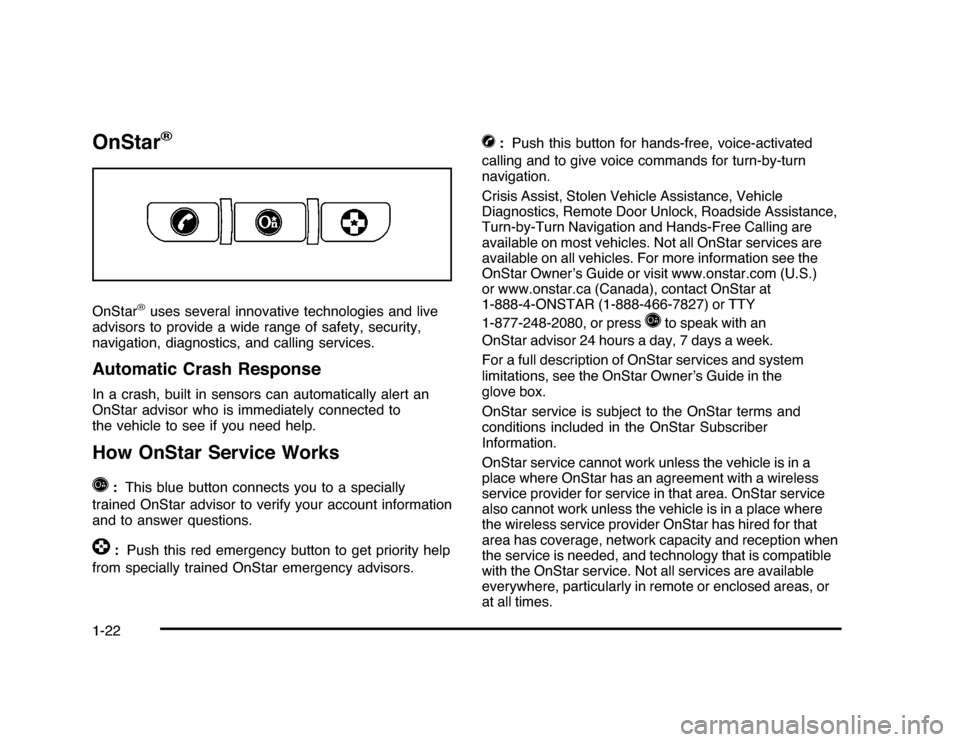
OnStar
®
OnStar
®
uses several innovative technologies and live
advisors to provide a wide range of safety, security,
navigation, diagnostics, and calling services.
Automatic Crash ResponseIn a crash, built in sensors can automatically alert an
OnStar advisor who is immediately connected to
the vehicle to see if you need help.How OnStar Service Works
Q
:This blue button connects you to a specially
trained OnStar advisor to verify your account information
and to answer questions.
]
:Push this red emergency button to get priority help
from specially trained OnStar emergency advisors.
X
:Push this button for hands-free, voice-activated
calling and to give voice commands for turn-by-turn
navigation.
Crisis Assist, Stolen Vehicle Assistance, Vehicle
Diagnostics, Remote Door Unlock, Roadside Assistance,
Turn-by-Turn Navigation and Hands-Free Calling are
available on most vehicles. Not all OnStar services are
available on all vehicles. For more information see the
OnStar Owner’s Guide or visit www.onstar.com (U.S.)
or www.onstar.ca (Canada), contact OnStar at
1-888-4-ONSTAR (1-888-466-7827) or TTY
1-877-248-2080, or press
Q
to speak with an
OnStar advisor 24 hours a day, 7 days a week.
For a full description of OnStar services and system
limitations, see the OnStar Owner’s Guide in the
glove box.
OnStar service is subject to the OnStar terms and
conditions included in the OnStar Subscriber
Information.
OnStar service cannot work unless the vehicle is in a
place where OnStar has an agreement with a wireless
service provider for service in that area. OnStar service
also cannot work unless the vehicle is in a place where
the wireless service provider OnStar has hired for that
area has coverage, network capacity and reception when
the service is needed, and technology that is compatible
with the OnStar service. Not all services are available
everywhere, particularly in remote or enclosed areas, or
at all times.
1-22
Page 31 of 432
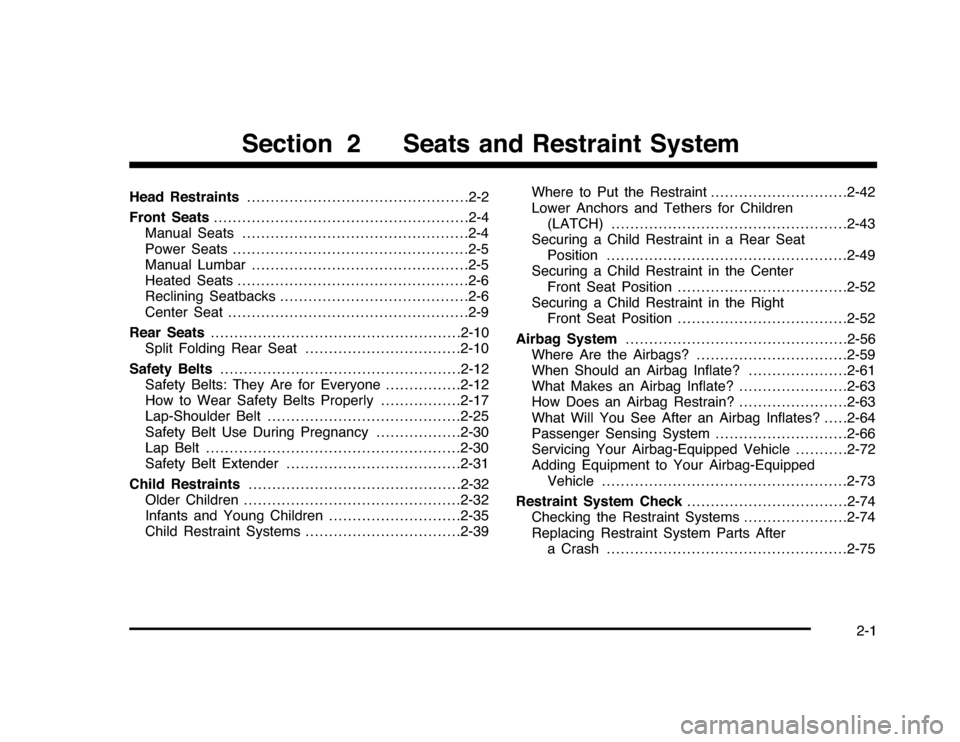
Head Restraints...............................................2-2
Front Seats......................................................2-4
Manual Seats................................................2-4
Power Seats..................................................2-5
Manual Lumbar..............................................2-5
Heated Seats.................................................2-6
Reclining Seatbacks........................................2-6
Center Seat . . .................................................2-9
Rear Seats.....................................................2-10
Split Folding Rear Seat.................................2-10
Safety Belts...................................................2-12
Safety Belts: They Are for Everyone................2-12
How to Wear Safety Belts Properly.................2-17
Lap-Shoulder Belt.........................................2-25
Safety Belt Use During Pregnancy..................2-30
Lap Belt......................................................2-30
Safety Belt Extender.....................................2-31
Child Restraints.............................................2-32
Older Children..............................................2-32
Infants and Young Children............................2-35
Child Restraint Systems.................................2-39Where to Put the Restraint.............................2-42
Lower Anchors and Tethers for Children
(LATCH)..................................................2-43
Securing a Child Restraint in a Rear Seat
Position...................................................2-49
Securing a Child Restraint in the Center
Front Seat Position....................................2-52
Securing a Child Restraint in the Right
Front Seat Position....................................2-52
Airbag System...............................................2-56
Where Are the Airbags? . . ..............................2-59
When Should an Airbag Inflate? . . ...................2-61
What Makes an Airbag Inflate?.......................2-63
How Does an Airbag Restrain?.......................2-63
What Will You See After an Airbag Inflates? . . . . .2-64
Passenger Sensing System............................2-66
Servicing Your Airbag-Equipped Vehicle
...........2-72
Adding Equipment to Your Airbag-Equipped
Vehicle....................................................2-73
Restraint System Check..................................2-74
Checking the Restraint Systems......................2-74
Replacing Restraint System Parts After
a Crash...................................................2-75
Section 2 Seats and Restraint System
2-1
Page 41 of 432
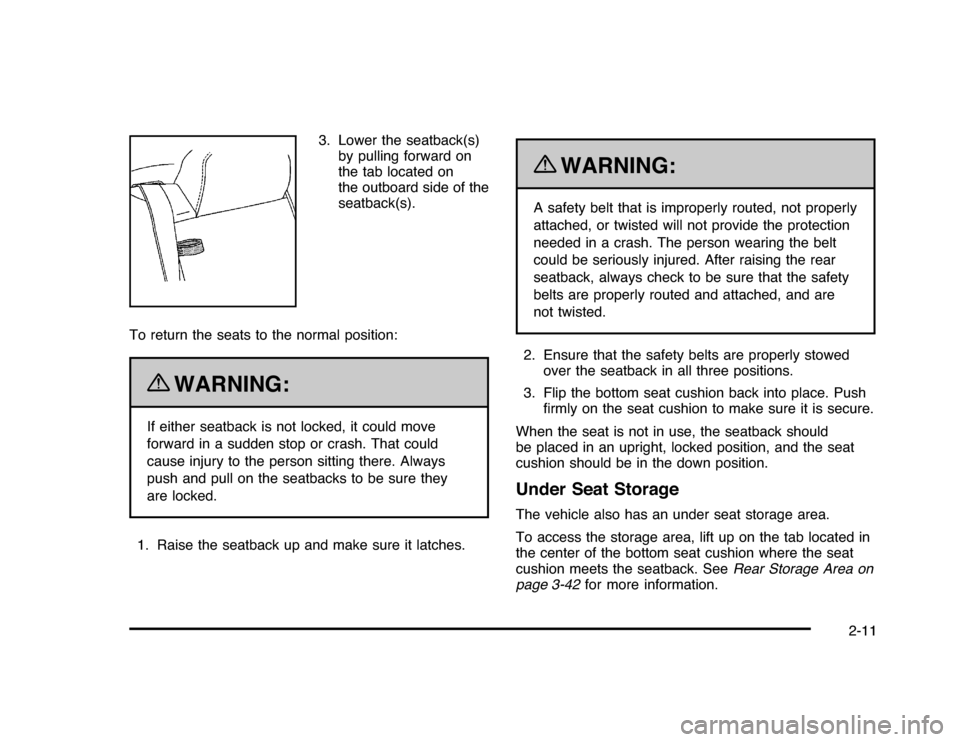
3. Lower the seatback(s)
by pulling forward on
the tab located on
the outboard side of the
seatback(s).
To return the seats to the normal position:
{
WARNING:
If either seatback is not locked, it could move
forward in a sudden stop or crash. That could
cause injury to the person sitting there. Always
push and pull on the seatbacks to be sure they
are locked.
1. Raise the seatback up and make sure it latches.
{
WARNING:
A safety belt that is improperly routed, not properly
attached, or twisted will not provide the protection
needed in a crash. The person wearing the belt
could be seriously injured. After raising the rear
seatback, always check to be sure that the safety
belts are properly routed and attached, and are
not twisted.
2. Ensure that the safety belts are properly stowed
over the seatback in all three positions.
3. Flip the bottom seat cushion back into place. Push
firmly on the seat cushion to make sure it is secure.
When the seat is not in use, the seatback should
be placed in an upright, locked position, and the seat
cushion should be in the down position.
Under Seat StorageThe vehicle also has an under seat storage area.
To access the storage area, lift up on the tab located in
the center of the bottom seat cushion where the seat
cushion meets the seatback. SeeRear Storage Area on
page 3-42for more information.
2-11
Page 55 of 432
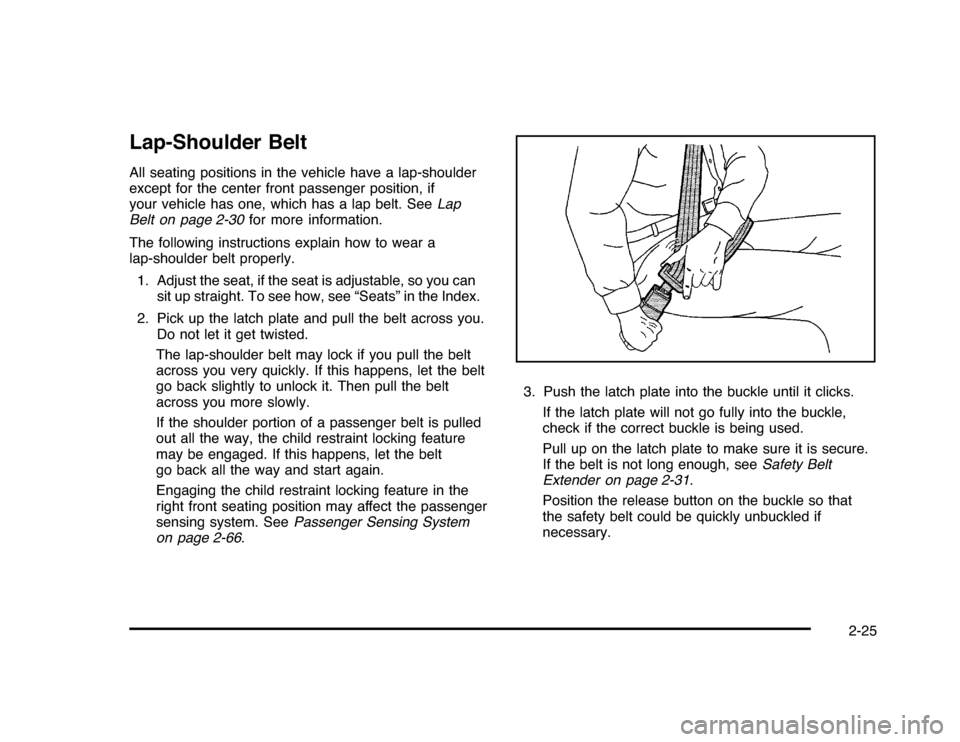
Lap-Shoulder BeltAll seating positions in the vehicle have a lap-shoulder
except for the center front passenger position, if
your vehicle has one, which has a lap belt. SeeLap
Belt on page 2-30for more information.
The following instructions explain how to wear a
lap-shoulder belt properly.
1. Adjust the seat, if the seat is adjustable, so you can
sit up straight. To see how, see “Seats” in the Index.
2. Pick up the latch plate and pull the belt across you.
Do not let it get twisted.
The lap-shoulder belt may lock if you pull the belt
across you very quickly. If this happens, let the belt
go back slightly to unlock it. Then pull the belt
across you more slowly.
If the shoulder portion of a passenger belt is pulled
out all the way, the child restraint locking feature
may be engaged. If this happens, let the belt
go back all the way and start again.
Engaging the child restraint locking feature in the
right front seating position may affect the passenger
sensing system. SeePassenger Sensing System
on page 2-66.3. Push the latch plate into the buckle until it clicks.
If the latch plate will not go fully into the buckle,
check if the correct buckle is being used.
Pull up on the latch plate to make sure it is secure.
If the belt is not long enough, seeSafety Belt
Extender on page 2-31.
Position the release button on the buckle so that
the safety belt could be quickly unbuckled if
necessary.
2-25
Page 61 of 432
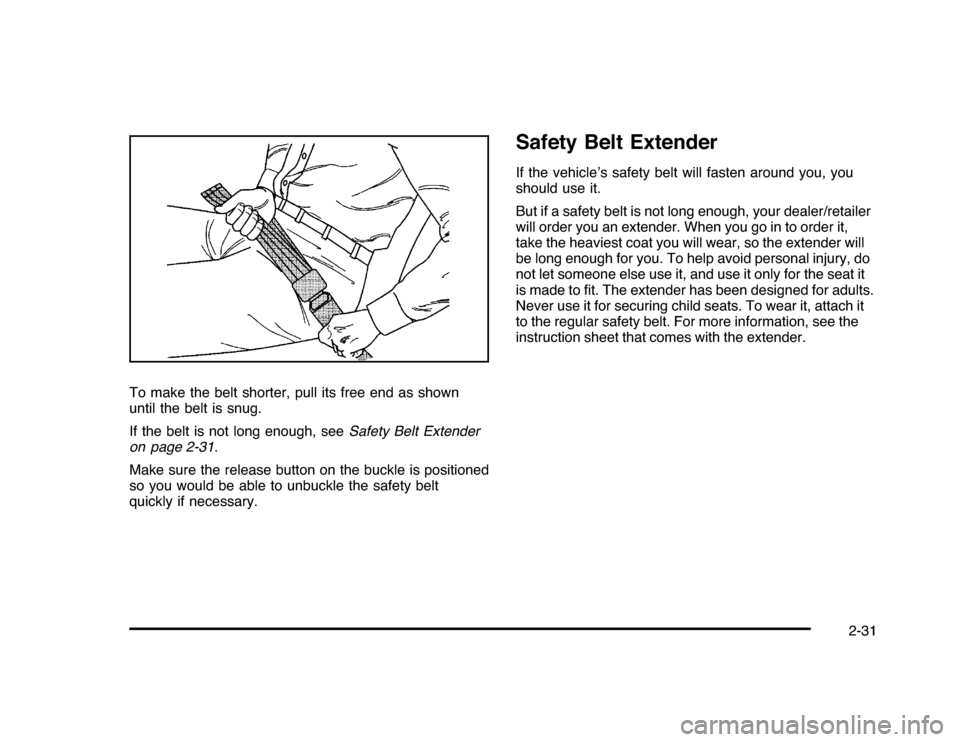
To make the belt shorter, pull its free end as shown
until the belt is snug.
If the belt is not long enough, seeSafety Belt Extender
on page 2-31.
Make sure the release button on the buckle is positioned
so you would be able to unbuckle the safety belt
quickly if necessary.
Safety Belt ExtenderIf the vehicle’s safety belt will fasten around you, you
should use it.
But if a safety belt is not long enough, your dealer/retailer
will order you an extender. When you go in to order it,
take the heaviest coat you will wear, so the extender will
be long enough for you. To help avoid personal injury, do
not let someone else use it, and use it only for the seat it
is made to fit. The extender has been designed for adults.
Never use it for securing child seats. To wear it, attach it
to the regular safety belt. For more information, see the
instruction sheet that comes with the extender.
2-31
Page 66 of 432
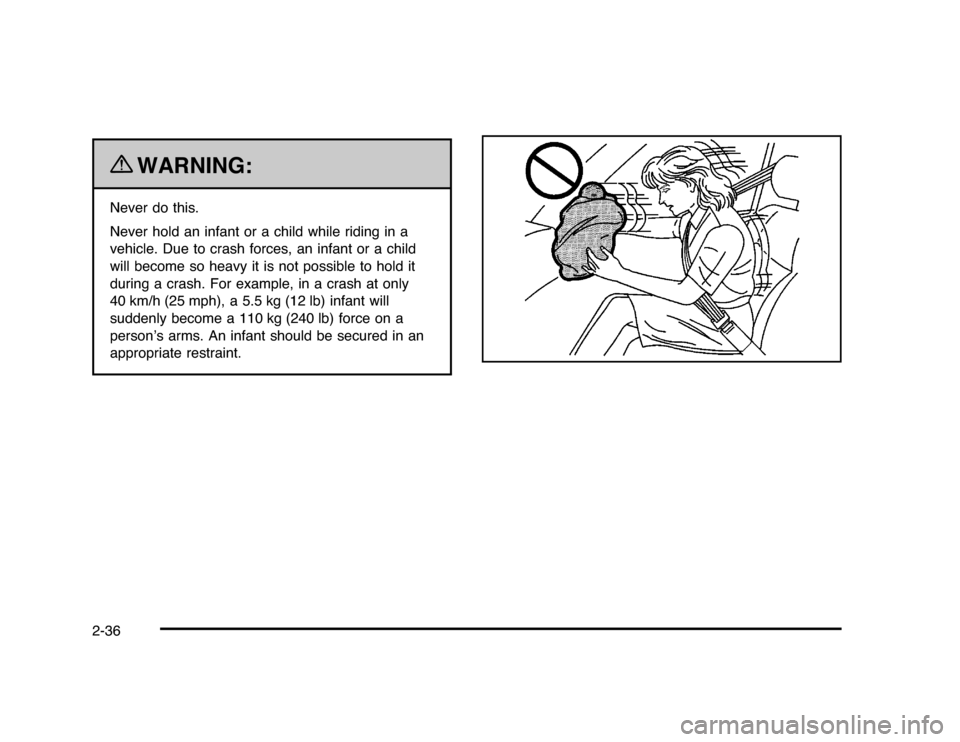
{
WARNING:
Never do this.
Never hold an infant or a child while riding in a
vehicle. Due to crash forces, an infant or a child
will become so heavy it is not possible to hold it
during a crash. For example, in a crash at only
40 km/h (25 mph), a 5.5 kg (12 lb) infant will
suddenly become a 110 kg (240 lb) force on a
person’s arms. An infant should be secured in an
appropriate restraint.
2-36
Page 67 of 432
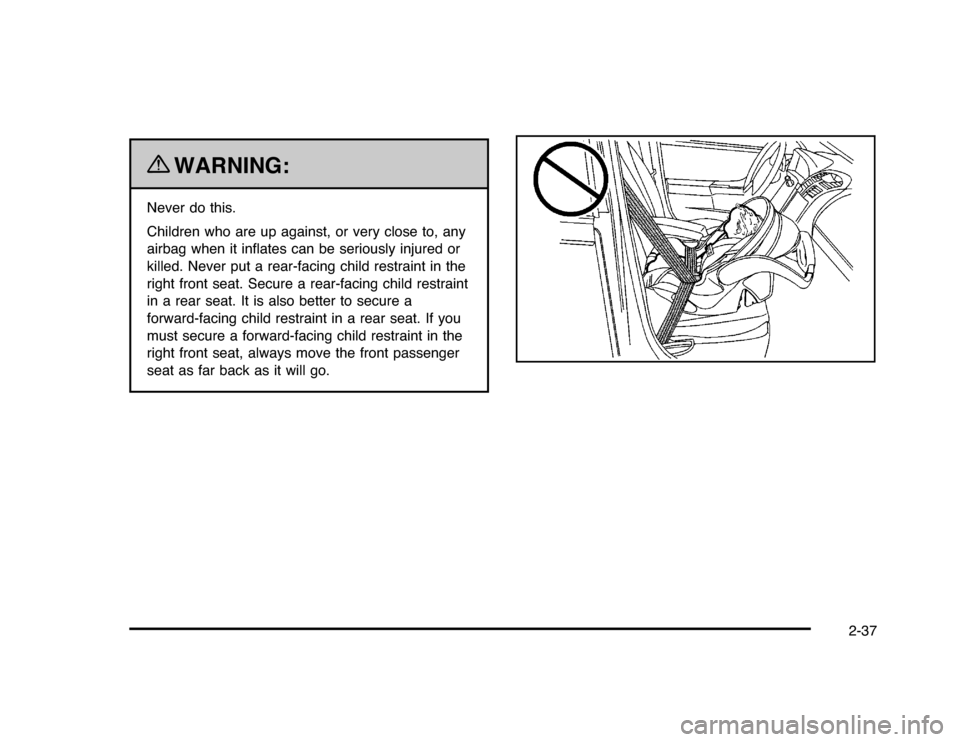
{
WARNING:
Never do this.
Children who are up against, or very close to, any
airbag when it inflates can be seriously injured or
killed. Never put a rear-facing child restraint in the
right front seat. Secure a rear-facing child restraint
in a rear seat. It is also better to secure a
forward-facing child restraint in a rear seat. If you
must secure a forward-facing child restraint in the
right front seat, always move the front passenger
seat as far back as it will go.
2-37
Page 68 of 432
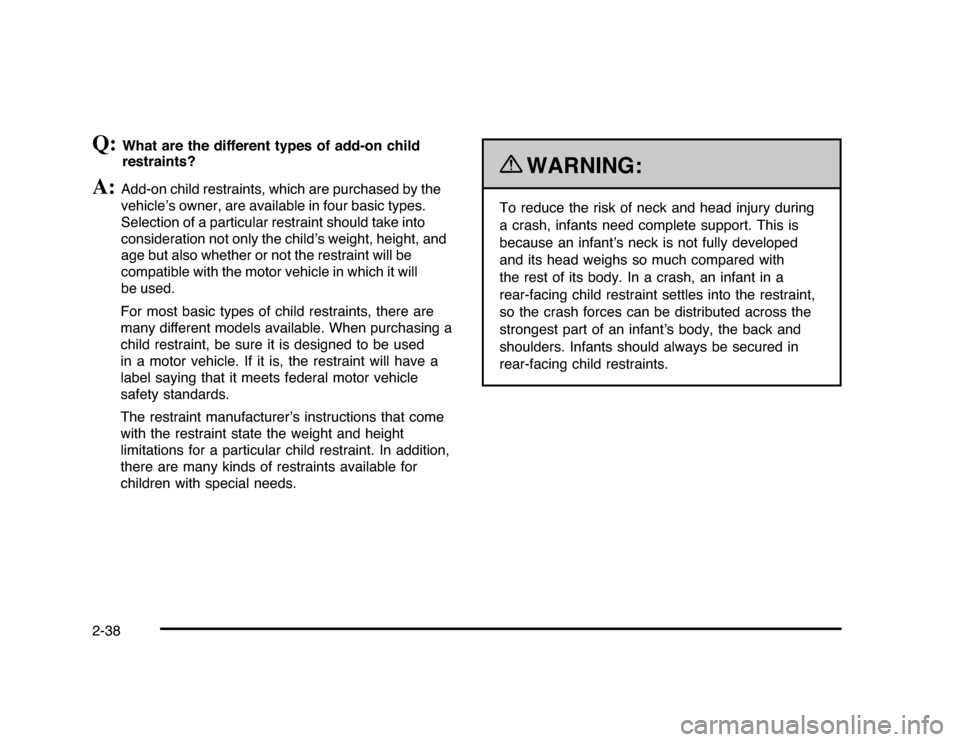
Q:
What are the different types of add-on child
restraints?
A:
Add-on child restraints, which are purchased by the
vehicle’s owner, are available in four basic types.
Selection of a particular restraint should take into
consideration not only the child’s weight, height, and
age but also whether or not the restraint will be
compatible with the motor vehicle in which it will
be used.
For most basic types of child restraints, there are
many different models available. When purchasing a
child restraint, be sure it is designed to be used
in a motor vehicle. If it is, the restraint will have a
label saying that it meets federal motor vehicle
safety standards.
The restraint manufacturer’s instructions that come
with the restraint state the weight and height
limitations for a particular child restraint. In addition,
there are many kinds of restraints available for
children with special needs.
{
WARNING:
To reduce the risk of neck and head injury during
a crash, infants need complete support. This is
because an infant’s neck is not fully developed
and its head weighs so much compared with
the rest of its body. In a crash, an infant in a
rear-facing child restraint settles into the restraint,
so the crash forces can be distributed across the
strongest part of an infant’s body, the back and
shoulders. Infants should always be secured in
rear-facing child restraints.
2-38